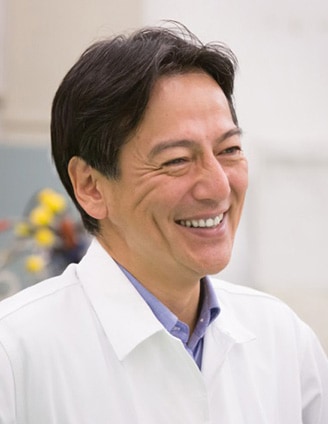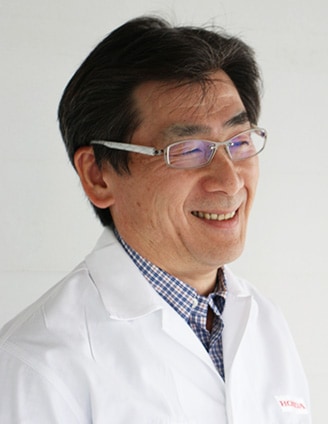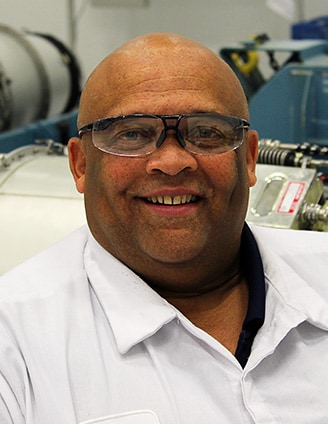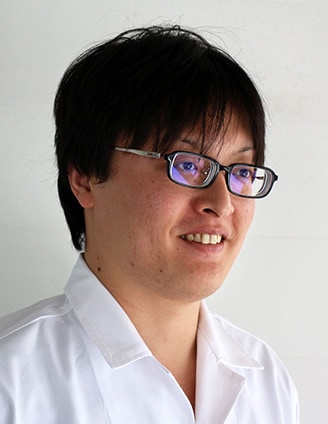Technology
Introduction to the Structure of the HF120, the spirit of engineers who supported the technology and the quality of the HF120, and the award history of the HF120
Spirit of engineers who supported the technology and the quality of HF120
Development responsible members

Power to achieve the dream
Atsukuni Waragai
Managing Director of Aircraft Engine R&D Center Honda R&D Co., Ltd.
(As of 2013)
At the beginning, we firmed up our theories. In the areas where we were not able to prove our theories through analysis, we conducted testing. We experienced many failures during the testing, but we never gave it up. I believe our dream came true by the lessons from those failures and our “never give up” spirit. By utilizing “The Power of Dreams” and Honda’s unique R&D environment which allows failures while challenging very high targets, we are committed to provide unparalleled aircraft engines to the market.

Achieve a high target without compromise. That is Honda’s DNA
Yoshihiko Wajima
General Manager of Aircraft Engine R&D Center
Honda R&D Co., Ltd.
(As of 2013)
Ever since the project started, we have been working on research and development under the policy that we think and we act on our own, rather than copying someone else. Because we always set goals high, and had a strong spirit not to compromise but to accomplish the goals no matter how many times we fail. I think such an aspiration encouraged us to successfully create engines that proudly boast the category-leading performance, and bring them into the world. That is truly Honda Spirit.

Don’t imitate the product that already exists
Etsuo Noda
HF120 Development Project Leader of Aircraft Engine R&D Center
Honda R&D Co., Ltd.
(As of 2013)
Based on Honda's traditional philosophy that allows a team of amateurs to start research and development, but never lets us copy other companies, we have carried out almost all of designing, manufacturing and testing by our own hands. With a strong desire to outdo every competitor in environmental performance, we pursued engines that emphasize fuel consumption and emission. The road to the final commercialization was long one with pain and suffering, but we have been paving the way for it step by step steadily and patiently for 30 years. It proved the teaching our predecessor used to say, “persistence pays off.”

Honda’s challenges are for the customers' pleasure
Masahiko Izumi
President of Honda Aero, Inc.
(As of 2013)
The quality control in the aviation industry is very strict, but we have been challenging for quality even far more stringent than that. Quality improvement requires a wide range of technologies such as engine development, design and production, and we were always facing issues to solve. We, however, had a strong motivation that we wanted our customers to fly safely with peace of mind. That’s why not only did we continue to research and develop jet engines for over 30 years, but also we could integrate the knowledge related to quality we have nurtured through developing motorcycles, automobiles and power products, into development of jet engines. Encouraged by such a fusion beyond the boundary of each specialty over a long persistent period, I am convinced that we could successfully create engines that achieve the quality of the world’s highest standard.
Engineers of Production & Service AUTOMOTIVE TO AEROSPACE

AUTOMOTIVE TO AEROSPACE
Charlene Weaver
Senior Manager of Engine Manufacturing Division
Honda Aero, Inc.
(As of 2013)
My career at Honda began just after graduation from the University of Pittsburgh where I received an Industrial Engineering degree. I started in the automotive frame division at the Marysville Auto Plant in Ohio in 1989. There, I experienced multiple major model changes of many Honda models/types that were produced at a very high volume.
Now, I focus on overseeing the production of only HF120 aircraft engines, and the volume is less than one unit per day. The challenges are different, but struggles still exist every day. We produce a precise and high quality product with extremely tight tolerances and specifications.
This product requires a production certification from FAA to be able to ship to customers. Receiving this certification was a significant milestone for our company. This program has been a true example of the Honda challenging spirit. My hope for the future is to see many models of our jet engine being sold to multiple customers.

Our Goal is to be the Best!
Jim France
Manager of Quality Assurance Division
Honda Aero, Inc.
(As of 2013)
I have been with Honda over 20 years and my career began in the automotive side of Honda in Ohio.
We must clearly identify and meet these complex requirements in order to sell and service the products produced at HAI. We are expected by HACI and end-users to identify and exceed these requirements on a daily basis, and we are also required by the government representatives to meet the specific requirements of their country where planes are sold.
I have been challenged with the need to ensure that we can verify the status and airworthiness of each part used in our engines. The manufacturing, testing and traceability of each component are requirements of the aviation industry that is on a higher level than the automotive industry. We must be able to verify and show records to the authorities that we are complying with these stringent requirements.
However, my hope is that we continue to build and ship the most technologically advanced and fuel efficient jet engines in the world for our category. We hope we can continue to positively expand Honda’s presence as a global leader in the aviation industry.

We bring our customers joy not just with our products, but also with our services
Matt Daly
Manager of Sales & Customer Service Division
Honda Aero, Inc.
(Title in 2013)
I joined Honda in 1998 as a member of Product Development Department at Honda’s Marysville Automobile Plant. There, I worked in the Denso Group on development of airbags, wire harnesses, switches, and audio/navigation.
I was transferred to HAI in 2006, and have had roles in Configuration Management, Supplier Development, and Customer Service. For many years, I focused on the quality of our products, now I focus on the quality of our product service to customers. In aviation, regular maintenance and inspections are required by regulations, therefore the quality of our product service is critical to keep aircrafts airworthy.
At HAI, I have the opportunity to hear the voices of our customers directly, and as our fleet grows with deliveries around the world, my team has the challenge to ensure they stay happy with their products. I have found that customer joys come not just from the products we make, but how we as a company offer the best service possible. The product service plays a key role in helping Honda achieve worldwide customer satisfaction.
Development Engineers

High quality comes from technology and communication
Ikue Kawasumi
Development Division
Aircraft Engine R&D Center
Honda R&D., Ltd.
(As of 2013)
I was assigned to engine development of automobiles when I first joined Honda, but I always wanted to be involved in aircraft engines. In my fifth year, I was finally transferred to the aircraft engine team, from which I could have an experience to go on a long-term business trip to the US, visiting the GE's test facility. During the trip in 2008, I was entrusted with the responsibility for supporting certification tests. Problems occurred during the testing, and I always felt a pressure when I faced such ordeals. In my ardent desire to develop the highest quality engines, however, I tried hard to explain to GE and Honda engineers what exactly was happening during the test, and managed to solve the problems through cooperation with every member of my team. To continue pursuing the highest quality of aircraft engines, I would like to further improve my skill and technical expertise based on the belief that communication is indispensable.

Challenge of young generations leads to quality improvement
Takayuki Tan
Development Division
Aircraft Engine R&D Center
Honda R&D., Ltd.
(As of 2013)
When I joined Honda, HF120 was in the midst of certification exams, and the entire R&D Center (former Aero Engine Center) was working on remaining quality issues. Amid such a tense circumstance, however, the development project leaders and managers at the time were willing to listen to my ideas, and spend a lot of time with me for discussions over the issues even though I was a mere young associate. The experience that my ideas were eventually accepted to solve the problems, I felt that I could contribute to quality improvement, and gave me a sense of confidence in challenging something new. “Equality before technology” is one of the Honda's philosophies, and by continuing to challenge with enthusiasms and logics regardless of age, I would like to aim for an engine with even higher quality.

Engine reliability comes from the Teamwork
Yuta Akai
Development Division
Aircraft Engine R&D Center
Honda R&D., Ltd.
(As of 2013)
The US Federal Aviation Administration (FAA) requires particularly high reliability from software that controls aircraft engines. Soon after I started working for Honda, I was assigned to the most important phase among the roles that involve demonstrating the reliability. Although I was a young member who just joined the company at that time, I was blessed with such a big opportunity. To verify the behavior of software in the environment that simulated an actual flight was complicated and required a high level of skill, but I believe that the support from my team members helped me complete the verification methods, and fulfill the task of explaining the methods and their results to FAA. As the spirit of Honda says that “we achieve a goal as a team regardless of job titles or age,” I will make my all-out efforts to improve the reliability of engines we make with the teamwork sprit of Honda.